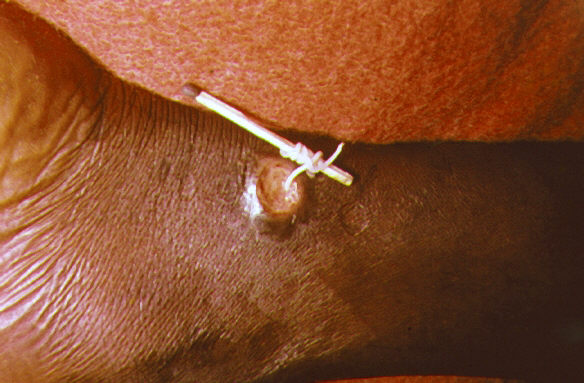Dracunculiasis

Dracunculiasis (Guinea worm disease) is a neglected tropical disease (NTD) characterized by a painful burning skin lesion from which the Dracunculus medinensis parasite emerges approximately 1 year after infection resulting from consumption of unsafe drinking water containing parasite-infected copepods (Cyclops spp., microcrustacea also called water fleas).
Epidemiology
In 2012, 542 cases were reported in 4 countries (Chad, Ethiopia, Mali, and South Sudan), a decrease of >99% since 1990. The global dracunculiasis program aims to eradicate the parasite from the last remaining endemic villages located in difficult to reach areas.
Clinical description
Clinical manifestations appear 10-14 months after infection and include constitutional symptoms (such as low-grade fever, itchy rash, nausea, vomiting, diarrhea, dizziness) followed by a localized swelling developing into a painful blister, most often on a lower limb. On contact with water, the adult female worm (70-100 cm) bursts through the blister, depositing her larvae in the water where they are consumed by copepods, starting the cycle anew. Local inflammation and secondary bacterial infection of the lesion are common, potentially causing cellulitis, abscess formation, tetanus (see this term), sepsis, and septic arthritis. If the lesion is near a joint, this may lead to joint contractures and permanent disability. If the worm is not fully removed it can create an intense inflammatory reaction that further exacerbates the pain, swelling, and cellulitis.
Etiology
Dracunculiasis is caused by the parasitic worm Dracunculus medinensis. Transmission occurs after drinking water contaminated with copepods that act as intermediate hosts to the infective parasite larvae. Copepod digestion in the gastrointestinal tract releases the larvae, which migrate to subcutaneous tissues where they mate and pregnant female worms mature.
Diagnostic methods
Dracunculiasis diagnosis is based on the typical appearance of a skin lesion with a protruding worm, commonly on a lower limb.
Differential diagnosis
Occasionally, another parasitic worm called Onchocerca volvulus, pieces of connective tissue, or fly larvae are confused with emerging Dracunculus medinensis worms.
Management and treatment
There is no effective medication or vaccine for dracunculiasis. Infected persons do not become immune to subsequent infection. Treatment is a long painful process consisting of pulling out the emerging worm by rolling it around a piece of gauze or a small stick, a few centimeters a day, in combination with wound cleaning and dressing with antibiotic ointment to prevent secondary bacterial infection.
Prognosis
Dracunculiasis is not life threatening itself but, rarely, death due to secondary sepsis has been reported. More commonly, the patient is disabled by pain during worm removal, on average for 8.5 weeks, which often has a great impact on everyday life in endemic areas. Joint contractures and permanent disability can occur in some cases.